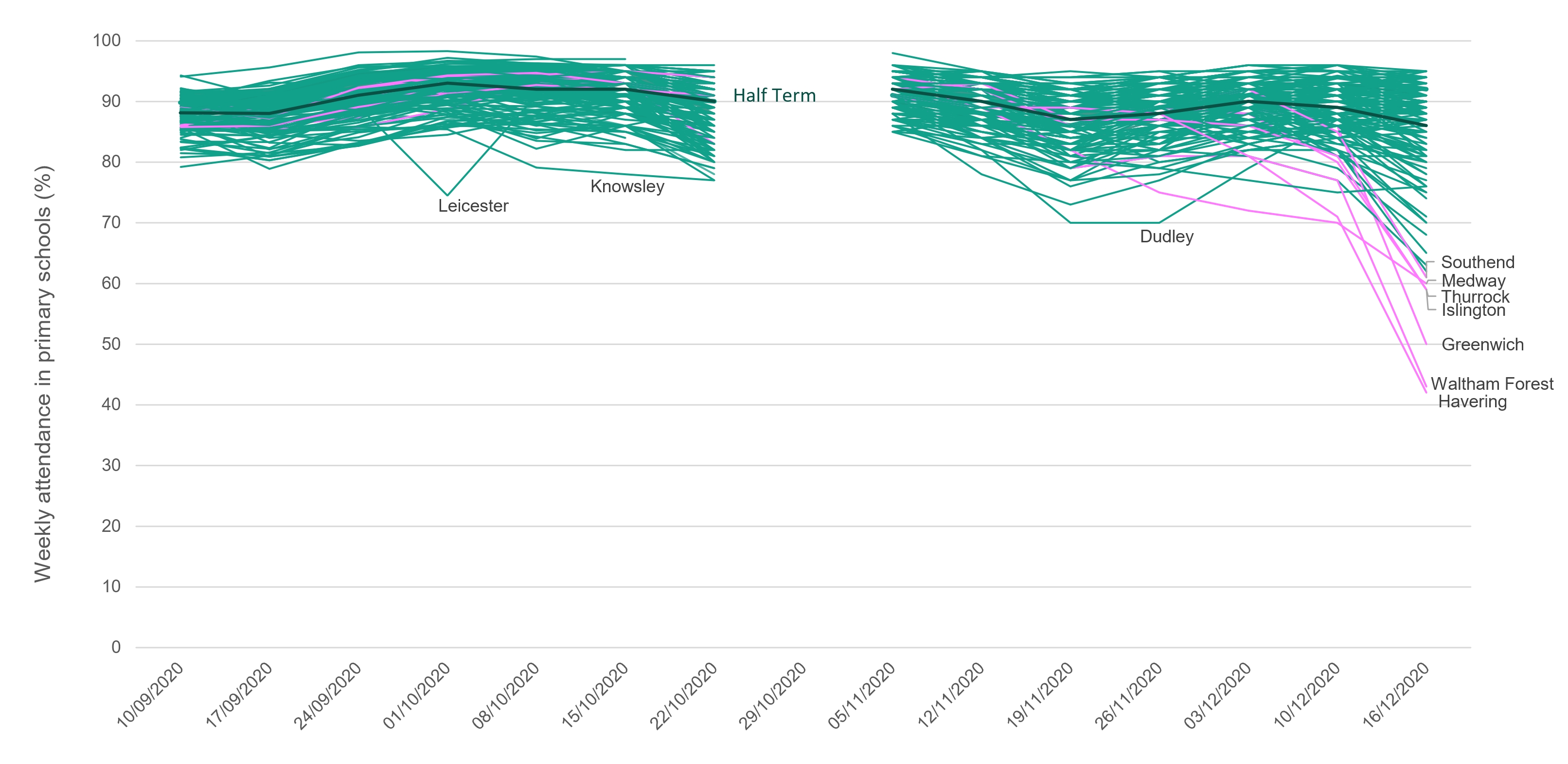Summary
- This week, the Department for Education published data on school attendance by local authority over the whole of the 2020 autumn term. This short analysis presents some initial analysis of the changes over time, including during the very dramatic last week of term.
- As per official figures, all figures for attendance by local authority are based on the Thursday of each week. The only exception is the last week of term, which is based on Wednesday December 16th instead of Thursday December 17th. This matches the approach used in official figures, though the overall patterns are very similar for December 17th. Figures are only shown when response rates were greater than 50 per cent.
Attendance in secondary schools
- Average attendance in secondary schools was about 80-85 per cent over most of the autumn term. This varied significantly by local authority, from about 70-90 per cent in most weeks.
- It was not always the same local authorities with low attendance each week, with some local authorities showing low attendance one week and then recovering to higher levels (e.g. Newcastle and South Gloucestershire). Others showed more persistent declines (e.g. Sandwell and Medway).
- Things changed dramatically in the last week of term, with national secondary attendance dropping to 72 per cent. This matches the upsurge in COVID infections during mid to late December.
- The drop was enormous around London and the Thames estuary, with secondary attendance dropping to about 40-45 per cent in Bexley, Bromley, Enfield, Reading and Greenwich, about 35 per cent in Medway and Kent, and under 25 per cent in Redbridge, Thurrock and Havering.
- The majority of these falls in attendance are explicitly related to COVID (either because of actual/suspected infections or as close contacts). The share of secondary pupils absent for known COVID-related reasons is estimated to be up to 30 per cent of pupils in all the highlighted cases, and sometimes much higher (up to 60 per cent in Havering and up to 70 per cent in Thurrock). Other absences will include parents withdrawing pupils early before Christmas because of a fear of infection/isolation.
Figure 1. Secondary school attendance by local authority in England over the 2020 autumn term (click on image to expand)
Attendance in primary schools
- Primary school attendance was higher over the autumn term, about 90 per cent in most weeks. Though this varied from 80-95 per cent across local authorities.
- Primary school attendance also dropped sharply in the last week of term, falling to a low of 86 per cent across England.
- It also dropped very sharply around London and the Thames estuary. Falling to 60 per cent in Medway, Southend, Islington and Thurrock, 50 per cent in Greenwich, and just over 40 per cent in Waltham Forest and
- The very sharp falls in Greenwich and Islington across both primary and secondary schools are very noteworthy as these are local authorities that initially wanted to move to remote learning for the last week of term, but pressure from central government forced them to change plans.
- The low attendance rates in Waltham Forest and Redbridge will reflect the fact that these local authorities allowed schools to move to online learning during the last week of term, despite central government advice.
Figure 2. Primary school attendance by local authority in England over the 2020 autumn term (click on image to expand)
Policy Lessons
There seem to be two main lessons:
- Falls in school attendance can be fast and dramatic when community infections are surging.
- Data transparency and timeliness is key. This national and local authority data would have led to a much more informed debate about the feasibility and merits of opening schools at the start of January. The data should have been published much earlier, not nearly a month after the event.
This research is supported by the National Association of Headteachers (NAHT).





